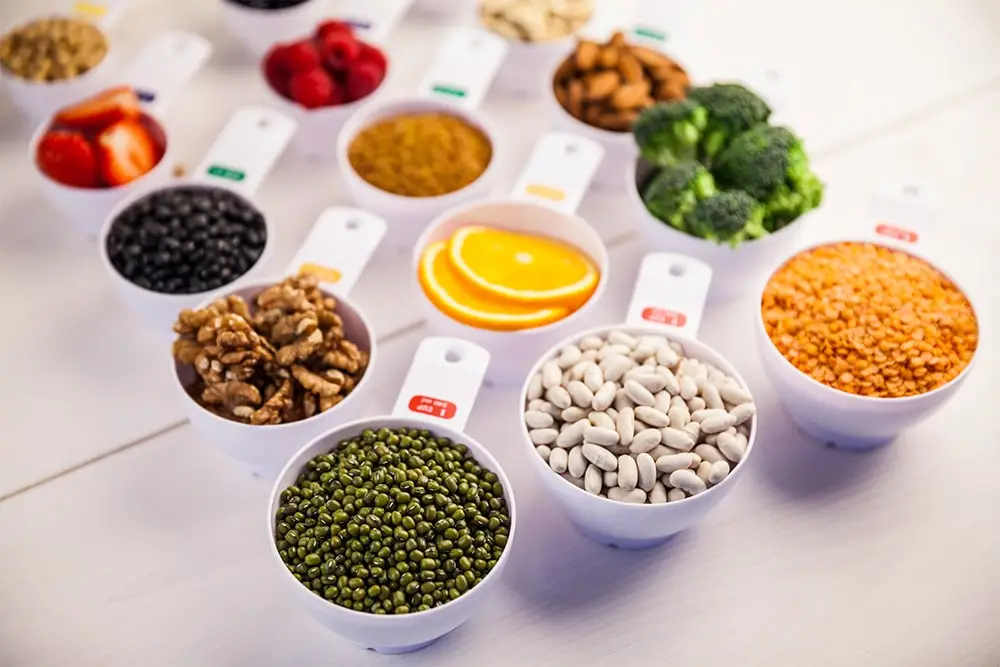
UK food manufacturers are constantly facing new challenges in navigating food labeling requirements. Accurate food labeling ensures legal compliance and helps build consumer trust by promoting transparency in nutritional information. A key aspect of this is the correct use of Nutrient Reference Values (NRVs) and Reference Intakes (RIs), which guide the labeling of vitamins, minerals, and other nutrients.
These values are essential for complying with UK and European Food Safety Authority regulations while meeting consumer expectations for clear, understandable nutritional information. Nutrient reference values play a vital role in ensuring products are marketed in a way that aligns with health standards. Companies like Food Label Maker can help food businesses generate compliant labels that reflect accurate nutrient information, aiding manufacturers in their compliance efforts.
What Are Nutrient Reference Values (NRVs)?
NRV stands for Nutrient Reference Values. NRVs outline the daily intake levels of essential vitamins and minerals, helping consumers understand how much of their daily intake is covered by a particular food item. For example, the recommended NRV for vitamin C is 80 mg per day.
This helps consumers of the general population understand how much of their daily intake is covered by a particular food item and they act as benchmarks for manufacturers to provide accurate nutritional content on their product packaging.
Reference Intakes (RIs) in UK Food Labelling
Previously called Guideline Daily Amounts (GDAs), NRVs are now part of Reference Intakes (RIs), which also include macronutrients like fats, carbohydrates, and proteins, and reflect more accurate consumption patterns.
RIs, such as 2,000 kcal for energy and 50g for protein, guide the recommended daily intake for an average adult and appear on food labels to help consumers make informed dietary choices. Manufacturers must understand both NRVs and RIs to ensure compliant and informative food labels that meet UK and European regulation.
The current UK guidelines for RIs are as follows:
- Energy: 8,400 kJ/2,000 kcal
- Total fat: 70g
- Saturates: 20g
- Carbohydrate: 260g
- Total sugars: 90g
- Protein: 50g
- Salt: 6g
These figures are based on an average-sized woman performing an average amount of physical activity, and they are displayed on food labels to give consumers a baseline for daily nutrient consumption.
While a Nutrient Reference Value is used to set estimated average requirements for vitamins and minerals, RIs focus on energy and macronutrients like fats, carbohydrates, and protein. For food manufacturers, understanding and applying both NRVs and RIs is essential for providing compliant and informative food labels that meet UK and European Food Safety Authority standards.
See How FoodLabelMaker Can Help You
Understanding Dietary Reference Values (DRVs) in the UK
Dietary Reference Values (DRVs) are essential nutrition recommendations that underpin UK nutrition policy. These values guide food manufacturers, nutritionists, and health professionals in promoting optimal health across various population groups.
DRVs consist of four key types:
- Estimated Average Requirement (EAR): The average daily nutrient intake estimated to meet the needs of 50% of healthy individuals in a specific group. For example, the EAR for energy for adult women aged 19-64 is 2,103 kcal/day.
- Reference Nutrient Intake (RNI): Set to meet or exceed the nutrient requirements of 97.5% of the population. For instance, the RNI for calcium in adults aged 19-64 is 700 mg/day.
- Lower Reference Nutrient Intake (LRNI): The lowest intake to meet the needs of those with lower requirements (2.5% of the population). The LRNI for iron in adult men is 4.7 mg/day.
- Safe Intake: Used when there is insufficient data for an EAR, this level is deemed adequate for almost everyone. For example, the adequate intake of vitamin D for adults is 10 μg/day.
DRVs vary across nutrients and differ from Reference Intakes (RIs) in their specificity. While RIs provide a single value for adults on food labels, DRVs offer more detailed, age and gender-specific recommendations for nutrition policy and dietary planning.
The Committee on Medical Aspects of Food and Nutrition Policy (COMA) initially set these values in 1991. Now, the Scientific Advisory Committee on Nutrition (SACN) regularly reviews and updates them based on new evidence, such as the revised nutrition recommendations for vitamin D in 2016 and dietary fibre in 2015.
For food manufacturers, understanding DRVs is crucial for product development, especially when targeting specific age groups or making nutrient content claims. Aligning with these values helps businesses contribute to public health goals while meeting regulatory requirements.
Calculation of Energy Values and Nutrient Amounts

To ensure compliance, UK food manufacturers must accurately calculate the energy and nutrient content of their products. This includes determining the macronutrient composition—such as fat, protein, and carbohydrates—and reflecting the correct values on product labels. These calculations can be based on laboratory analyses, average ingredient values, or trusted databases.
There are several acceptable methods for determining nutrient values for food labeling in the UK:
- Scientific analysis of food: Nutrient values can be obtained through laboratory analysis of the finished product.
- Calculations from average values of ingredients used: Manufacturers may calculate nutrient values based on known averages for the ingredients in their products.
- Use of established data sources: Trusted databases, such as McCance & Widdowson’s Composition of Foods, can provide reliable nutrient information.
Maintaining accuracy is crucial, as misleading or incorrect labelling can result in penalties or loss of consumer trust.
Manufacturers also need to distinguish between nutrient values for food as sold and food after preparation, particularly if cooking or preparation affects the nutrient content. When nutrient values are given for food after preparation, detailed instructions must be provided to ensure consistency.
Tolerances and Variability in Declaring a Nutrient Reference Value
Due to the variable nature of food composition, nutrient values on food labels are subject to a certain degree of tolerance. This variability can stem from factors like production methods, seasonal changes, and storage conditions. The European Commission’s guidance on nutrient tolerances provides a framework for setting allowable margins of error when declaring nutrients.
In the UK, carbohydrate values are determined by the amount of “available carbohydrate,” which excludes fiber content. This means when calculating carbohydrates for labeling purposes, only sugars and starches are included, with fiber listed separately. When calculating calories, carbohydrates are counted as 4 calories per gram, while fiber is counted as 2 calories per gram.
Manufacturers must ensure that nutrient values remain within these tolerances to avoid misleading consumers. While there may be variations, compliance with these tolerances is essential for maintaining transparency and adhering to regulatory standards. Proper monitoring and adjustment of nutrient declarations help maintain accuracy while accounting for natural variability in food products.
Fibre Content in Nutrition Labelling
In the UK, there is no specific Reference Intake (RI) for fibre on standard food labels, despite health guidelines recommending a daily intake of 30g for adults. While fibre is an important nutrient, manufacturers can choose to label fibre content voluntarily. For products meeting certain thresholds, claims like “source of fibre” (at least 3g per 100g) or “high in fibre” (at least 6g per 100g) are allowed as they give consumers more insight into the nutritional benefits of a product.
Fibre isn’t the only nutrient with specific UK recommendations – free sugars and saturated fats also have guidance to encourage healthier food production and consumption habits. For food manufacturers, accurately labeling fibre content not only helps comply with UK regulations but also caters to growing consumer interest in dietary fibre for digestive health.
Age-Specific Nutrient Recommendations for Adequate Intake

Nutritional requirements vary significantly across different stages of life, and the UK’s Dietary Reference Values (DRVs) outline specific nutrient needs for each group.
For example:
- Infants and young children need higher levels of protein per kilogram of body weight to support rapid growth and development.
- Adolescents, particularly those going through puberty, require more calcium for bone growth and iron for increased blood volume.
- For adults, nutritional requirements tend to stabilize, but maintaining adequate intake of all essential vitamins and minerals is crucial for long-term health.
- In older adults, most nutrients like vitamin D become especially important, as the body’s ability to synthesize this nutrient from sunlight decreases with age, making supplementation and dietary intake more critical.
Food manufacturers producing age-specific products must ensure that nutrition declarations reflect these differences in recommended daily allowances. Clear, targeted labeling helps meet the nutritional needs of an average healthy person at various life stages while also ensuring regulatory compliance and enhancing product appeal.
Practical Implications for UK Food Manufacturers
UK food manufacturers must integrate nutrient reference value amounts and reference intakes into their labelling processes to ensure compliance with regulatory requirements. Non-compliance can lead to legal and financial penalties, making accurate nutrient declarations essential.
Food Label Maker’s software offers an efficient solution, helping manufacturers navigate UK labelling regulations, including age-specific nutrient needs and NRVs. By streamlining the process, businesses can ensure their labels are compliant and consumer-friendly.
Conclusion
Understanding and complying with NRVs and RIs is crucial for UK food manufacturers to meet regulatory standards and provide consumers with accurate nutritional information. Staying up-to-date with changing guidelines ensures that manufacturers produce clear, compliant labels that promote consumer trust and healthier dietary choices.
By using platforms like Food Label Maker, manufacturers can simplify the process of creating compliant food labels, building a strong reputation for transparency and reliability in the market. Accurate labelling not only meets regulatory demands but also supports informed consumer choices.



